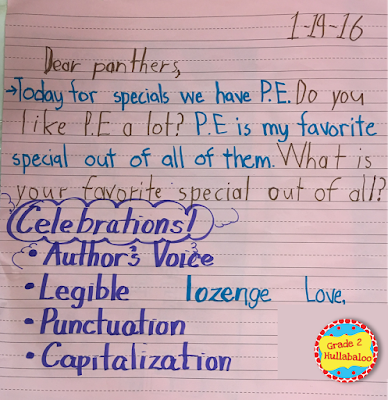While cleaning out my classroom, in order to move to a different one, I found a whole bunch of chart tablets the children had used for morning message this year. True to my TPRN (Teacher Pack Rat Nature), I shoved them behind a bookcase and forgot about them. I thought there might be a time we could use the paper for something!
As I flipped through them, I said, "Wow!" I was amazed by the progression of the children's writing skills. It made me feel all warm and fuzzy... and proud. I was reminded of how versatile morning meeting, specifically, morning message time, can be. All those mornings, we had worked on grammar and writing skills in those ten (or less) minutes while reading and discussing the morning message each day.
Disclaimer: The chart photos you will see here are NOT Pinterest worthy -- not by a longshot, but they will help me to explain how this successful meshing of grammar and writing mini-lessons on voice, editing, and word choice helped my students. The daily reminder to indent a paragraph, or add a closing and a signature to a friendly letter, worked. In small, daily doses, our conversations influenced my students' work in ELA content areas AND social skills.They learned to wait their turn, give constructive criticism, and to wait their turn.
NOTE: Morning Message is attributed to The Responsive Classroom and is detailed in The Morning Meeting Book by Roxann Kriete and Carol Davis.
Our 10-Minute Process
Each morning, the stars (one girl and one boy helper for the day) put away their things, get organized, and begin writing the morning message. Before I turn students loose with morning message, I model this for a couple of weeks by having the message written when students arrive. The first few messages that I write are error free.
After I teach the process and expectations for our dialogue, I include intentional mistakes. This helps me teach editing and revision along with the thought processes associated with each part of the writing process. Examples might include every sentence beginning with the same word, omitted words, misspelled words (grade level or easily decodable), tired words (good, bad, sad, glad) or incorrect punctuation.
NOTE: In my district, we are not allowed to teach writing skills during the ELA block. Students may respond to reading in a reading journal or practice page, but the deliberate teaching of writing skills is not allowed. This is a big no-no! So, I must squeeze in a few grammar skills at the beginning of my daily writing block or other subjects -- just not during the ELA block. Occasionally, I will use an entire writing block to introduce a grammar skill, and follow-up work is completed during RTI time. That is IF students aren't coming to me for RTI. It gets a bit hairy trying to juggle it all, sometimes!
Turning it Over to the Kids
One way that I build in the probability of a great start is to make sure I begin the independent writing on a day that at least one capable leader is the star. This ensures we'll have a confident writer in the pair of scribes for the message. It's gratifying to see a student help another one while drafting the message! On the days the stars have their turn to write the message, they are excused from the morning warm-up work.
We gather on the carpet and read the message. THEN... we sing part of Kool & The Gang's Celebrate.
"Celebrate good times, oh yeah!
Hm-Hm, Hm-Hm, Hm, Hm, Hm, Hm,
Oh, yeah!"
By the time we have finished singing that portion of the song, I have had time to write 'Celebrations' under the message (see the first example below). I ask for volunteers for celebrations (compliments). I list these as the children point out the great things the authors of the message included. It could be indentions, punctuation, or capitalization.
You'll notice in the first message, we discussed author's voice.
Here is Teaching Point Number 1 -- Author's voice helps us experience the author's thoughts through his word choice and phrasing.
I may need to remind students that author's voice simply means that the author wrote in a way that we can imagine "hearing" them saying the things they wrote; in other words, they wrote very much like the way they speak. Author's voice is a tough idea, so lots of repetitions and examples are necessary.
Sometimes, a word will come up, which leads to a quick mini-lesson on vocabulary, syllabication or vowel sounds. You'll note that 'lozenge' is written on the chart. I had been reading Because of Winn-Dixie and one child pronounced legible with a hard /g/ in the first syllable. I used lozenge as an example of the soft /g/ sound to help the child make the connection. (If you haven't read Because of Winn-Dixie, you MUST! When you do, you'll know why I used lozenge. :-)
Teaching Point Number 2 -- Connections to our reading help us to use richer, more descriptive language.
After the celebrations are listed, it is time for suggestions for improvement. This is where the kiddos get super nit-picky, and I sometimes have to reel them in a bit. However, the peer-to-peer feedback is more powerful than any I can give. If the cool, smart kid suggests a classmate should indent next time, you can bet that kid will indent!
Teaching Point Number 3 -- Peer-to-peer feedback helps classmates fill in gaps in skill sets.
One thing I encouraged ( a lot!) was for the scribes to venture out more with their messages. Below is an example, albeit a messy one, of how these two students made an attempt at avoiding the typical, "Today's special is art. Do you like art? Art will be fun." I explain to them that the same message every day becomes gets boring and predictable.
From this example, you can see that I didn't agree that they were on track; they didn't stay on topic. We discussed it, and we agreed that it was mostly on track (which is generous). You can also see that these two got a little messy with the editing marks -- scribbles to mark out unwanted or misspelled words instead of straight lines. So, I modeled how to correct a misspelled word ("anywhere"). I also modeled how to change today into a possessive noun as in "today's."
Teaching Point Number 4 -- Introduce or review editing marks.
Teaching Point Number 5 -- Review singular, possessive nouns.
As you can see, in about ten minutes, I reviewed possessive nouns and editing marks and discussed connections between what we have read and how those connections help us with our writing.
In looking through those charts of all the morning messages, I formulated a plan for next year:
I will still model morning messages for the first couple of weeks. I am going to start with the basics: sentences, subject/verb agreement, punctuation marks, 7UP sentences (7 or more words), and move to more complex skills after I have introduced them during writer's block.
How do you fit grammar skills into your day? Do you integrate skills similarly to this? Do you have a dedicated grammar block? Is it separate from writer's workshop? I'd love to hear how you fit it all in in your classroom. Leave a comment!






This is such a great idea! I think I'll have to look that book up this summer. Thanks for sharing! :)
ReplyDelete~Erin
Mrs. Beattie’s Classroom
Erin,
ReplyDeleteThanks! It's packed with great ideas for their 4 part approach -- morning messages, games to teach respect and cooperation, and so much more.
Thanks for visiting and commenting!
Hope your summer is fantastic!
Susan